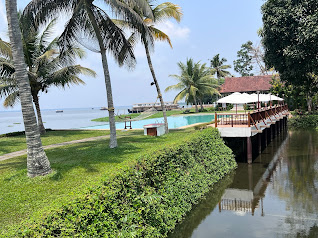 |
| Cruising on the backwaters of Kerala |
 |
| Chinese Fishing Nets |
Our next stop in India was Fort Kochi in Kerala, a sliver of
a state in the southwest corner of India. It’s a lot calmer than Mumbai
(although certainly not cooler). The state of Kerala is known for its natural
beauty, lush green areas, tranquil backwaters and one more thing - it has
the highest
literacy rate in India - 96.2%. Interestingly, it also has
stronger and better enforced traffic laws, where motorbike users actually wear
helmets or they are ticketed, according to our great guide, Jayakrishnan. Hmm,
higher literacy rates AND safer traffic situations…Are they related? 😏
The highlight of our visit to Kerala was taking a leisurely
cruise on the backwaters of Alleppey. We drove a long way to an absolutely lovely
hotel in the countryside, Kumarakom Lake Resort. There we boarded a houseboat (just for the afternoon) on Vembanad
Lake and set off for a serene afternoon sail.
On another very hot night, we had a lovely evening with Nimmy Paul at a private cooking class in her home, where she attempted to show me some wonderful Keralan Syrian Christian recipes. Somehow her stir frying used a completely different technique than one I was used to. I usually scoop and turn over the ingredients to keep them moving. Nimmy just gently moved them around the oil in the pot. She didn't actually grab the wooden spatula out of my hand, but she indicated that I could use a gentler approach. 😬
Somehow I've misplaced all my paperwork from that night, so the pictures will have to suffice. But we enjoyed a lovely dinner afterwards (which had been mostly cooked by Nimmy😏) in her beautiful colonial, Keralan traditional home.
 |
| I'm not sure putting this photo in black and white hides the sweat pouring out of every pore, but I tried... |

Oh, after dinner, Nimmy and her helper wrapped me in a saree as they showed me the elaborate tying technique. 😄
Fort Kochi is a charming town and the
site of the first European fort in India, built by the Portuguese. Vasco de
Gama arrived in Kerala in 1498 (and was buried here in 1524 until his remains
were returned to Lisbon in 1538) and the Portuguese were officially ceded the
territory in 1503. They held onto it until 1683 when the Dutch took over and
ruled until 1795. Then the British defeated the Dutch and were in charge until
Indian independence in 1947.
 |
| St. Francis Church |
There are long swathes of material hung from the rafters, which are actually fans. They were operated by Indians in the olden sweltering days (which are still sweltering!). They pulled on ropes which were installed outside of the building and made a cooling breeze for the (probably way overdressed) Europeans in the pews. 😬
Another noteworthy thing about this church is that before
the Dutch came, the Portuguese buried folks inside the church. Later the
tombstones were moved to the walls and an outside graveyard became the customary
burial spot.
 |
| Royal Baby |


We drove past the Santa Cruz Basilica, one of seven basilicas in
Kerala. Our guide, Jayakrishnan, told us to take note of the brass flagpole in front of the church,
which he said comes from the Hindu influence in the region.
 |
| Okay, it's not the best photo, but you can see the pole. 😟 |
Every Hindu temple has a flagpole in front and during the different festivals the main priest will hoist a saffron and red flag. Christian basilicas in Kerala, like Santa Cruz, have the same kind of flagpole. On Christian holy days, the main priest flies a multi-colored flag, as a nod to one of the many cross-cultural influences in Kerala.
FYI, here's are two fantastic videos that Jayakrishnan sent me of a celebration at his local temple. (Note the elephants!)
 |
| Paradesi Synagogue |
Today there are two (yup, only TWO) Jewish residents left in Fort Kochi and so the synagogue is not used anymore. They need a quorum of ten adult males to make a minyan and be able to proceed with prayers. But it’s a beautiful space to visit.
The Kathakali performance of classical Indian dance was wonderful. It features male dancers acting out the male and female roles. The audience is invited to attend hours early to see the actors putting on their makeup. It is quite a sight.





















No comments:
Post a Comment